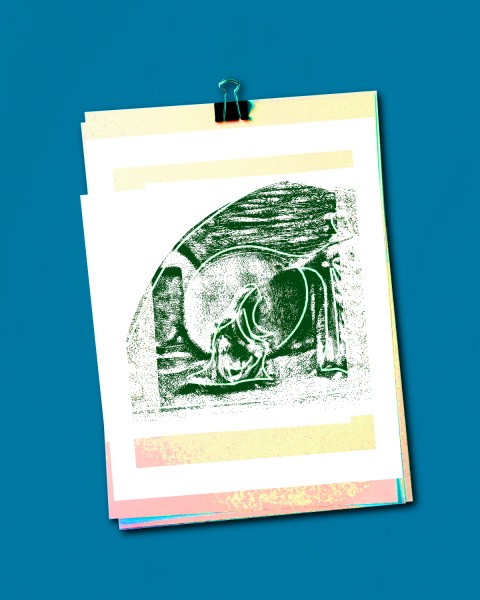Have things changed for women since the time of Mary Magdalene?
In a world where we aren’t trusted, Mary’s encounter with the risen Jesus is an act of solidarity.

Century illustration
This is not a great time to be a woman. Plus ça change, as my French sister-in-law might say. Fair point. Yet the evidence of a decline in women’s position in many societies is stacking up. In 2024, nearly half the world’s population took part in elections; in 60 percent of them, the number of female legislators fell. And perhaps the less said about having a man like Donald Trump back in office the better.
A few years back, some of us felt a flicker of hope when the Me Too movement appeared. I wondered if it might become a tipping point. Finally, I thought, women’s experiences and lives would be foregrounded. While I stand in awe at the persistence and courage of Gisèle Pelicot, her horrific experiences are a token of cultural modes that continue to treat women as second-class.
Read our latest issue or browse back issues.
Are women ever really trusted, except perhaps as mothers? Even then, in Christian contexts women often find that we are still held up against the impossible standard of Mary, the woman who is typically defined by her motherhood and yet remains “virginal” and “spotless.” None of us can match up to that.
In religion’s iconography of femininity there is another pole against which women are unfairly judged: Mary Magdalene. I do not mind admitting that I have been fascinated with her since I first saw the film version of Jesus Christ Superstar on TV in the late ’70s. OK, so the musical’s depiction of Mary as a sex worker obsessed with Jesus is hardly fair; at least she is a main character.
If Mary Magdalene so often embodies the “scarlet woman” trope, she also stands as an icon of Christian culture’s suspicion of women’s stories and of our seeming untrustworthiness. For—once we have stripped away the traducing of her character in tradition and culture—she is surely the first apostle of the resurrection. John’s Gospel makes her the very first witness, discovering the empty tomb and then reporting back this extraordinary news to the rest of Jesus’ closest circle (John 20:1–2). She is the messenger, or apostle, of disturbing news.
Of course, her word is not good enough. Peter and John insist on seeing what Mary has reported for themselves (vv. 3–10). In Luke’s version—in which other women join her in delivering the news—the lack of trust in female testimony is seen even more sharply: their “words seemed to [the disciples] an idle tale, and they did not believe them” (Luke 24:11).
Again, plus ça change. But that is not the end of the story, of the greatest story, as John’s version clearly shows. After Peter and John have undertaken their exercise in manly verification, they clear off, leaving Mary alone. In her love and grief, she weeps for her Lord. She is still unsure of what has happened. Is the tomb empty because the Romans or the temple authorities have stolen the body? What is going on? And then she sees two angels in white, sitting where the body of Jesus had been laid, one at the head and the other at the feet. They ask, “Why are you weeping?” and she replies, “They have taken away my Lord, and I do not know where they have laid him” (John 20:11–13).
This is the moment of extraordinary gift and wonder, of both seeing and unseeing, of true witness, of Easter encounter. As Mary turns around, she sees Jesus standing there, but she does not know that it is him. Jesus asks, “Woman, why are you weeping? For whom are you looking?” Mary even thinks he is the gardener. The simplicity of her statement is heartbreaking: “Sir, if you have carried him away, tell me where you have laid him, and I will take him away.” And then Jesus calls her by name, and she recognizes him. How does Mary respond? She wants to hold him close. Her instinct is the instinct of all who think they have lost a beloved and, to their surprise, receive them back (vv. 14–16).
Of course, this new beginning offered to Mary no longer conforms to old patterns of love, affection, and attention. “Do not cling to me,” says Jesus. The risen Jesus must ascend to the Father; the gift to Mary is the gift of a new world in resurrection, the gift of seeing reality and receiving grace renewed. Her call now is the awesome work of apostolic service: “Go to my brothers and say to them, ‘I am ascending to my Father and your Father, to my God and your God’” (v. 17).
Is Mary’s work as the first witness and apostle of resurrection a feminist moment? That is a question worthy of several books. What I’m sure of is that it is a moment when the old, fallen world is exposed for what it is. Mary is the first witness to the new creation in the risen Christ, yet she remains, infuriatingly, a woman under question. Witness also means martyr. Mary will be a martyr for a truth that is less trusted because it is delivered by a woman.
But Mary’s encounter is also a moment of solidarity. God does not offer the gift of first apostle to the usual suspects—the Peters and the Johns—but to a woman once troubled by spirits, a woman who sought out her Savior even after his death. God is in solidarity with those who need it most. And “Mary Magdalene went and announced to the disciples, ‘I have seen the Lord’; and she told them that he had said these things to her” (v. 18). She tries to tell us still. And, still, I am not sure we are really listening.







